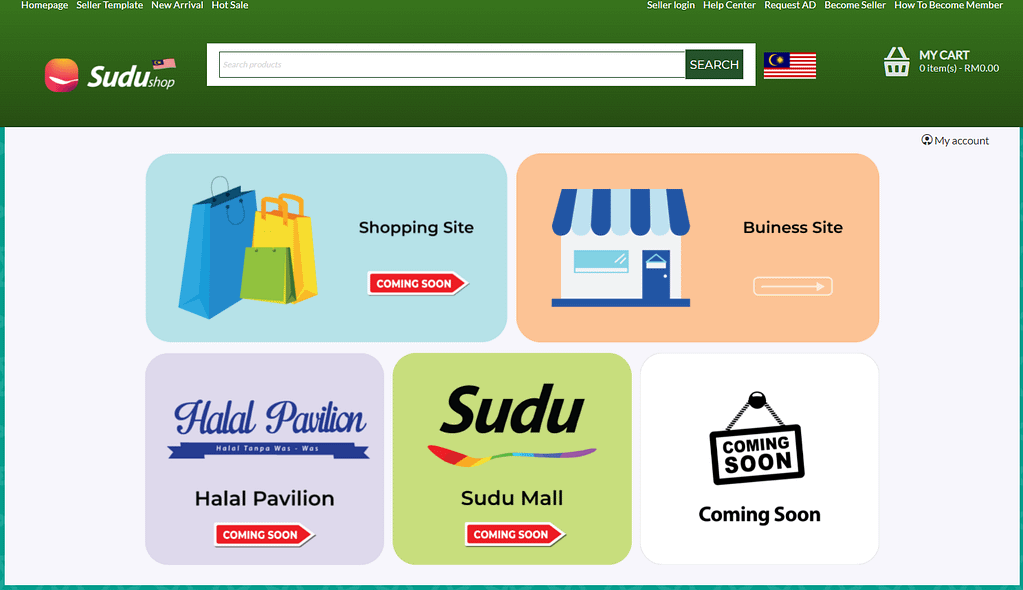What is MVP?
In the context of eCommerce, MVP (Minimum Viable Product) is an online store or marketplace with basic functionality that allows you to collect information about customer experience and demand at minimal cost. This is especially true in an unstable economic and political environment, when the speed of bringing your product to the market plays an important role. In this article, we give our insights about when to start a project with an MVP, what is important at the start, and what can be added later.
MVP stories of our clients
The main thing for an MVP is to collect feedback from the client and the first orders. To test the idea, you can create a landing page for a non-existent product to analyze demand and user response.
One of our clients asked us to finalize his site-catalog into a full-fledged marketplace. Sudushop (Malaysia) is just announcing the ability to buy products and download catalogs, inviting future buyers and sellers to apply. We are currently working on making their eCommerce MVP a full-fledged marketplace in the future.

Another way to submit an MVP is to pre-sell a product. The strategy is that on the site or in the store they describe the future product. Buyers can place a pre-order – pay a part of the cost or the full amount in order to reserve the product immediately after it is launched. This approach allows you to test the market while also opening the door to potential MVP funding opportunities.
An example is our client’s store – Sacrifice.now. The owner posted photos of the clothes on social media before the marketplace MVP itself was launched. As a result, he managed to collect a certain number of orders even before the launch of the site.

MVP advantages
MVP helps:
- Determine the necessary functionality of the online store in order to effectively spend time on development;
- Reduce the cost of creating an online store by introducing only important functions;
- Promptly launch the project and start making a profit;
- Make sure that the functionality is in demand, which means reducing the risk of wasting the budget in the shortest possible time and with minimal effort;
- Understand the potential payback and attract investors for the development of the project;
- Quickly identify and fix errors;
- Adjust the business model and create a roadmap for improvements for a full-fledged version of the online store based on the facts.
When do you need MVP and when a full-fledged development?
Doing a full-fledged project or starting with an MVP will depend on many factors, such as deadlines, project goals, environment, and so on. Let’s take a look at each of them.
- Project deadlines:
- If the implementation of the requirements for the project fits in 6-8 months, we can say that we are dealing with a foreseeable project. All requirements can be met in one iteration.
- If there are too many requirements at the start, or they are time-consuming, the implementation period exceeds 8 months, then it becomes difficult to design everything from the very beginning, given that the project environment and the requirements themselves can change a lot during implementation. Here we recommend splitting the project work into an MVP and further developments.
2. Project goals:
- If your goal is to test a hypothesis, MVP is your choice.
- If you come with a proven hypothesis, or you already have an established business (perhaps on a different platform or offline), have an established client base that is loyal to you, then it’s better to spend time and make a full-fledged project right away. So you do not spoil the impression of customers and save your reputation.
Don’t copy eCommerce giants at the start
Often, the owners of future online stores are afraid to miss any detail in the work of their project. They ask to implement all the possible functions that their future online store may need – from the simplest to the most complex.
The problem lies in prioritization: what needs to be done first, and what can be postponed until later. As a rule, the requests of such entrepreneurs are based on the experience of competitors and eCommerce giants with huge functionality that has already been implemented. It seems that without all these functions the site won’t be successful.
However, developing such a store is expensive and takes a lot of time. At the same time, the risks remain high, since complex functionality may not be in demand among buyers at the initial stages. And even if the development budget can be agreed upon, the project deadlines are stretched. The more features, the more resources are needed for development and debugging.
After creating an online store as an MVP for ecommerce website, it is important to determine the required minimum of functions, and after launch MVP, collect information about user experience and product demand. You need to think about the goal and remember: you can return your investment based on qualitative and quantitative research.
The general recommendation here is to start with a boxed version of CS-Cart and expand it with modules and a theme that better suits the requirements of the project, perhaps with minimal changes. As an MVP for a mobile application, we can offer PWAjet. This will significantly reduce the time and cost of launching and allow you to test the hypothesis. After launching MVP and testing the hypothesis, you can proceed to individual design and more complex developments.
What information you need to collect before launching an MVP project
Before developing an MVP, you need to have clearly defined business and functional requirements for the project. Ideally, but not necessarily, conduct a full-fledged study of the target audience and competitors of the future project. Here are some more materials that will help you and the contractor form the same vision of the MVP project:
- Competitor analysis
- Examples of competitors and implementation of the desired functionality
- Examples of companies you want to be like
- Description of the target audience (helps to shape the design of the store, taking into account the age and preferences of users, B2B or B2C functionality)
- Design layouts
- Development plans. For example, site load, project monetization methods, ROI plans, etc.
- List of roles of project participants (who is the end customer or who makes the decision). Decision-making scheme (for better alignment of work).
- User-cases (description of scenarios in a certain situation, for example, when the user registers, the following happens).
Learn more about tips on collecting requirements from our previous post.
eCommerce MVP for online stores and marketplaces based on CS-Cart
The fastest way to launch an MVP is to build it on off-the-shelf software.
- Choose the right platform for your business model:
- If there are two parties in the online store – the store administrator and the customer, then you select CS-Cart Enhanced with already integrated payment systems, delivery methods, SEO and other solutions.
- Multi-Vendor Enhanced has all the necessary functions for the marketplace, plus it is optimized for operations between the administrator, vendors and buyers. The boxed version of Multi-Vendor offers the most basic e-commerce features: a product catalog, basic vendor management tools, simple design features, some payment gateways, and checkout. You can extend functionality with no-code solutions: add-ons and themes. This is enough to test your idea.
2. Scale your project over time by expanding the capabilities of the platform:
- CS-Cart Enhanced -> CS-Cart Ultimate (Enhanced)
- Multi-Vendor Software (Enhanced) -> Multi-Vendor Plus (Enhanced) -> Multi-Vendor Ultimate
If you have a multi-storefront Multi-Vendor (Multi-Vendor Ultimate), and you set out to launch different marketplaces (with different product categories) on each storefront, then our recommendation is to implement each direction in turn.
Also, if you plan to work in several countries and have a dedicated storefront in each of them, start with one country (where there are customers or vendors) and then scale to other countries.
Sometimes, vendors come to you from different platforms (for example, Amazon, eBay and Etsy). Your desire to integrate with all platforms immediately is clear, but it is more rational to first integrate with one or two platforms that are most popular with your vendors, and then proceed to integrate all other platforms.
I would recommend taking things one step at a time. First, define your MVP (minimum viable product), launch your project, and only when you get the first feedback from your vendors and customers, proceed to introducing new features to the platform. It is important to implement new features only according to your vendors and target audience needs. So, start selling, collect feedback, study what your vendors and customers really need and make educated decisions about adding new features to your store. And we will always be there to help you customize your CS-Cart store to meet your business needs.

